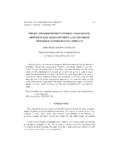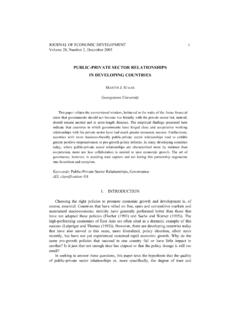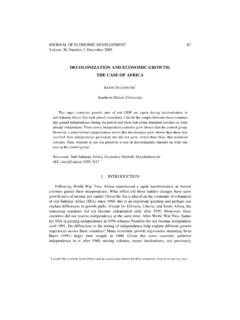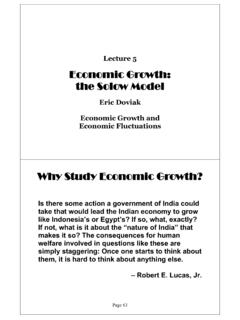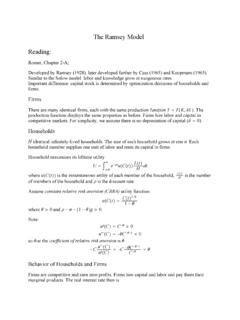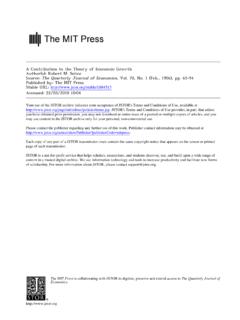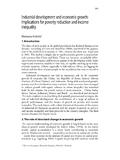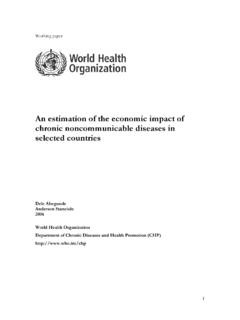Transcription of A Dynamic, Keynesian Model of Development - jed
1 JOURNAL OF ECONOMIC Development Volume 25, Number 1, June 2000 1 A Dynamic, Keynesian Model of Development Richard Grabowski and Michael P. Shields The Harrod-Domar growth Model is extended in a way that introduces the possibility of persistent excess capacity as a potential source of slow growth. This extended Model has five growth rates, which must be equal for there to be a full-employment, full-capacity dynamic equilibrium, instead of the three growth rates in the standard Harrod-Domar Model . These growth rates will be called the justified, the actual, the warranted, the potential and the natural rate of growth. This Model is held to provide a consistent framework for discussing many disparate view of economic Development . Specifically, much of Development theory can be divided in to three types of theories, which focus on different structural rigidities in the economy.
2 First, there are theories that emphasize a lack of saving and thus propose mechanisms for augmenting saving. Second, theories emphasizing a shortage of investment and thus the existence of excess capacity. Third, there are theories emphasizing inadequate labor absorption and the need to develop or employ labor by using capital saving technology. It is argued that the essence of Keynesian Development economics is the belief that the Development process is served better by pursuing policies that enhance growth with existing obstacles than by simply trying to remove these obstacles in the hope that Development will then occur. I. Introduction The Harrod-Domar growth Model , as it has been formulated and applied to Development economics, is as much neoclassical as it is Keynesian . There is no possibility of persistent excess capacity in the usual application of the Harrod-Domar Model because planned investment is assumed to equal planned saving.
3 The idea that some savings might not be invested was central to Keynes s view of the The typical Harrod-Domar Model is only partly Keynesian . Unemployment might exist because the economy is growing too slowly. By assumption, this slow growth is not due to low investment but to a low saving The equations of the Model are used to find the saving rate needed to achieve a given rate of growth. Hence, Development economists like Albert O. Hirschman, who are Richard Grabowski and Michael P. Shields are Professors in the Departments of Economics at Southern Illinois University - Carbondale and Central Michigan University, respectively. 1. This possibility is the key assumption in Palley s modification of the Solow Model to generate a Keynesian growth Model that is explicitly based on a neoclassical production function. See Palley (1996).
4 2. A rigid wage rate or a rigid production technology, in these models, prevents the capital-output ratio from adjusting to absorb the unemployed labor, which would create a higher growth rate. JOURNAL OF ECONOMIC Development 2 sympathetic to Keynes, have rejected the Harrod-Domar Model as being In this paper, we argue that a properly defined Harrod-Domar Model provides a framework for much of the thinking and theorizing on economic Development that has occurred since World War II. A dynamic, Keynesian Model will be developed which allows for the possibility that planned investment could be less than planned saving. Hence, as we will see, this Model will incorporate the possibility of persistent excess capacity as a potential source of slow growth with unemployment. This Model has five growth rates, which must be equal for there to be full-employment, full-capacity dynamic equilibrium, instead of the three growth rates in the standard Harrod-Domar Model .
5 These growth rates will be called the justified, the actual, the warranted, the potential and the natural rate of growth. The Model will be developed in the next section. Then various views of Development will be presented in terms of coping with rigidities that prevent adequate growth rates within the context of the Model . These rigidities are discussed in terms of factors preventing adequate investment, saving or labor absorption. Finally, the implications of the Model for understanding economic Development theory will be summarized. II. The Keynesian Growth Model Like any Model , the Model is constructed on many simplifying assumptions. First, saving, S, is assumed to be proportional to income, Y. So, S = sY where s equals the average and marginal propensity to save. The labor force is assumed to grow at a constant exogenous rate n and thus n = LL = L&.
6 In addition, for ease of exposition, technical innovation and capital depreciation will not be introduced into the Model . Goods and capital are assumed to be produced by a single, fixed proportion production function written as ,) uL ,vK( = Ymin (1) where v and u are, respectively, constant capital-output and labor-output ratios. There is the possibility that some capital, labor or both will not be utilized. The amount of capital that is utilized will be called required capital and will be denoted as Kr. Total capital is denoted as K and is utilized plus unutilized capital. Potential output is the output that would be produced if there is no unutilized or idle capital and if there is no binding labor constraint. Potential output is Q = K/v (2) and actual output is Y = Kr/v, (3) 3.
7 See Hirschman (1982). GRABOWSKI AND SHIELDS: A DYNAMIC, Keynesian Model OF Development 3 where v is the underlying capital-output ratio defined in Equation (1). Obviously Kr cannot exceed K. Planned investment, Ip, is defined as an increase in utilized capital and is assumed to be rY, = K = Irp& (4) where r is assumed to be Note that this Model differs from the usual Harrod-Domar formulation, where no distinction is made between K and Kr, or between I and The rate of growth of actual output or income, see Equation (3), is . Yv) / K( = Yr& (5) Substituting from Equation (4) into (5) yields ,r/v = Y (6) where r/v is the actual rate of growth, Ga.
8 Note that Ga is determined only by the marginal propensity to invest, r, and the capital-output ratio, v. The rate of growth of growth of capacity, Q , where Q is given in Equation (2), is . Qv) / K( = Q& (7) Total investment, K = I&, equals total saving, or sY= K&. (8) Substituting Equation (8) into (7) yields ,vs = vQ) / (Y s = Qv / sY = Qr (9) where . ) YQ ( v = vr The growth of potential output, Q , will be called the warranted rate 4. The assumption that investment is exogenous is made in many Keynesian models where investment is determined by expectations of future returns to investment and is thought to be insensitive to interest rates.
9 5. It should be emphasized that the Harrod-Domar Model differs in some ways from the original views of either Harrod or Domar. JOURNAL OF ECONOMIC Development 4 of growth and will be denoted as Before considering the labor supply, the dynamic stability of the Model will be considered. First, note that if r and s are constants then the Model is stable. Assume that initially Y = Q, implying that v = vr. If r = s then Ga = Gw and the economy continues to grow at the equilibrium rate. However, if r < s, planned investment is less than saving, then initially Ga < Gw and excess capacity appears. As a result vr rises until Ga = Gw. For this flow equilibrium to be maintained, entrepreneurs would have to become accustomed to wasted investment and idle capital as an inevitable element of investment and production. Otherwise, when facing excess capacity firms might decrease planned investment, reducing r.
10 If r falls, the equilibrium would be unstable. Again, Ga < Gw, which would generate additional excess capacity, raising vr, lowering Gw and leading to further reduction in r. A similar argument will apply in a situation where Ga > Gw. Hence, the economy would be unstable. For the economy to be stable, without excess capacity, r would have to rise when there is unplanned investment and excess capacity in the economy and fall when demand exceeds Note that our treatment of Harrod-Domar differs from the standard treatment in that excess capacity is incorporated into the equations. In the usual treatment, s/v is called the warranted rate of growth. To interpret s/v, note that s/v is the warranted rate only when there is no excess capacity. If excess capacity builds up, the warranted rate will fall. s/v is accordingly called the potential rate of growth, Gp.

